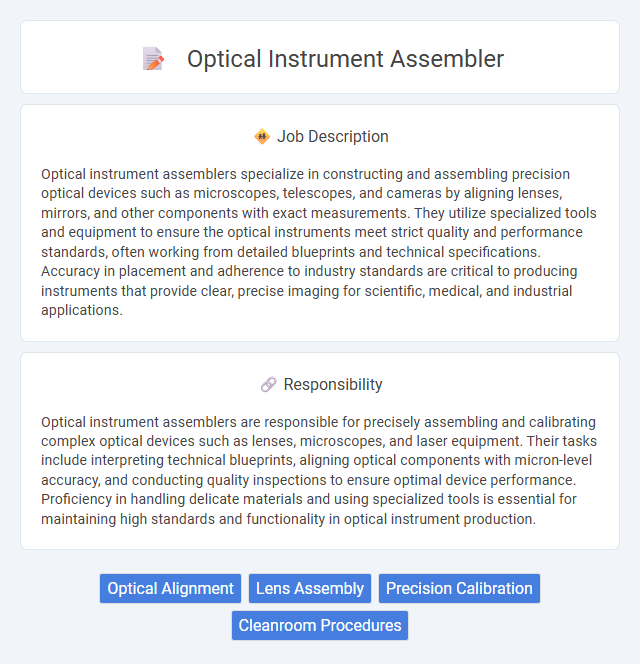
Optical instrument assemblers specialize in constructing and assembling precision optical devices such as microscopes, telescopes, and cameras by aligning lenses, mirrors, and other components with exact measurements. They utilize specialized tools and equipment to ensure the optical instruments meet strict quality and performance standards, often working from detailed blueprints and technical specifications. Accuracy in placement and adherence to industry standards are critical to producing instruments that provide clear, precise imaging for scientific, medical, and industrial applications.
Individuals with steady hands, sharp eyesight, and excellent attention to detail are likely well-suited for the optical instrument assembler role. People who may struggle with fine motor skills or have difficulty maintaining focus during repetitive tasks might find this job challenging. Those who thrive in precise, methodical work environments probably have a higher probability of success in this position.
Qualification
Optical instrument assemblers typically require a high school diploma or equivalent, with specialized training in optics, electronics, or mechanical assembly preferred. Proficiency in reading technical blueprints, precision measuring instruments, and adherence to strict quality control standards are essential qualifications. Experience with calibration techniques and familiarity with cleanroom environments further enhance job suitability in this field.
Responsibility
Optical instrument assemblers are responsible for precisely assembling and calibrating complex optical devices such as lenses, microscopes, and laser equipment. Their tasks include interpreting technical blueprints, aligning optical components with micron-level accuracy, and conducting quality inspections to ensure optimal device performance. Proficiency in handling delicate materials and using specialized tools is essential for maintaining high standards and functionality in optical instrument production.
Benefit
Optical instrument assembler roles likely offer benefits such as competitive wages and opportunities for skill development in precision assembly techniques. Employees may also receive health insurance, paid time off, and potential bonuses linked to performance. Job stability could be enhanced by working in industries with consistent demand for optical devices.
Challenge
Optical instrument assembler roles likely present complex challenges involving precise alignment and calibration of delicate components. These tasks may require meticulous attention to detail and steady hands to ensure instruments achieve optimal performance. Problem-solving skills are probably essential to address unforeseen assembly issues and maintain high-quality standards.
Career Advancement
Optical instrument assemblers gain specialized skills in precision assembly and calibration of lenses, prisms, and optical devices, opening pathways to advanced roles such as quality control inspector or technical supervisor. Mastery of complex optical systems and proficiency in troubleshooting enable progression to positions in research and development or optical engineering support. Continuous training and certifications in optics technology significantly enhance prospects for career advancement in the high-tech optics manufacturing industry.
Key Terms
Optical Alignment
An Optical instrument assembler specializes in precision optical alignment to ensure the accurate positioning of lenses, mirrors, and other components within devices such as microscopes, cameras, and telescopes. They use specialized tools like interferometers, autocollimators, and laser alignment systems to achieve optimal optical performance and minimize aberrations. Expertise in interpreting optical schematics and adherence to strict tolerance standards are critical for maintaining high-quality assembly and performance of optical instruments.
Lens Assembly
Optical instrument assemblers specializing in lens assembly focus on precisely aligning and securing lenses within devices such as microscopes, cameras, and telescopes. They employ techniques like cleaning, adjusting, and mounting lenses to ensure optimal optical performance and clarity. Proficiency in handling delicate glass components and using specialized tools is essential for maintaining accuracy and preventing damage in the lens assembly process.
Precision Calibration
Optical instrument assemblers specialize in the precision calibration of lenses, mirrors, and other optical components to ensure accurate performance and alignment. They use advanced tools such as interferometers and laser alignment systems to achieve micrometer-level tolerances in complex optical devices. Expertise in precision calibration directly impacts the reliability and functionality of instruments used in scientific research, medical applications, and high-tech manufacturing.
Cleanroom Procedures
Optical instrument assemblers must adhere strictly to cleanroom procedures to maintain contamination-free environments essential for high-precision components. They wear specialized garments, use antistatic tools, and follow protocols such as controlled airflow and particulate monitoring to prevent defects in optical assemblies. Mastery of these cleanroom standards ensures optimal functionality and reliability of advanced optical instruments.
 kuljobs.com
kuljobs.com